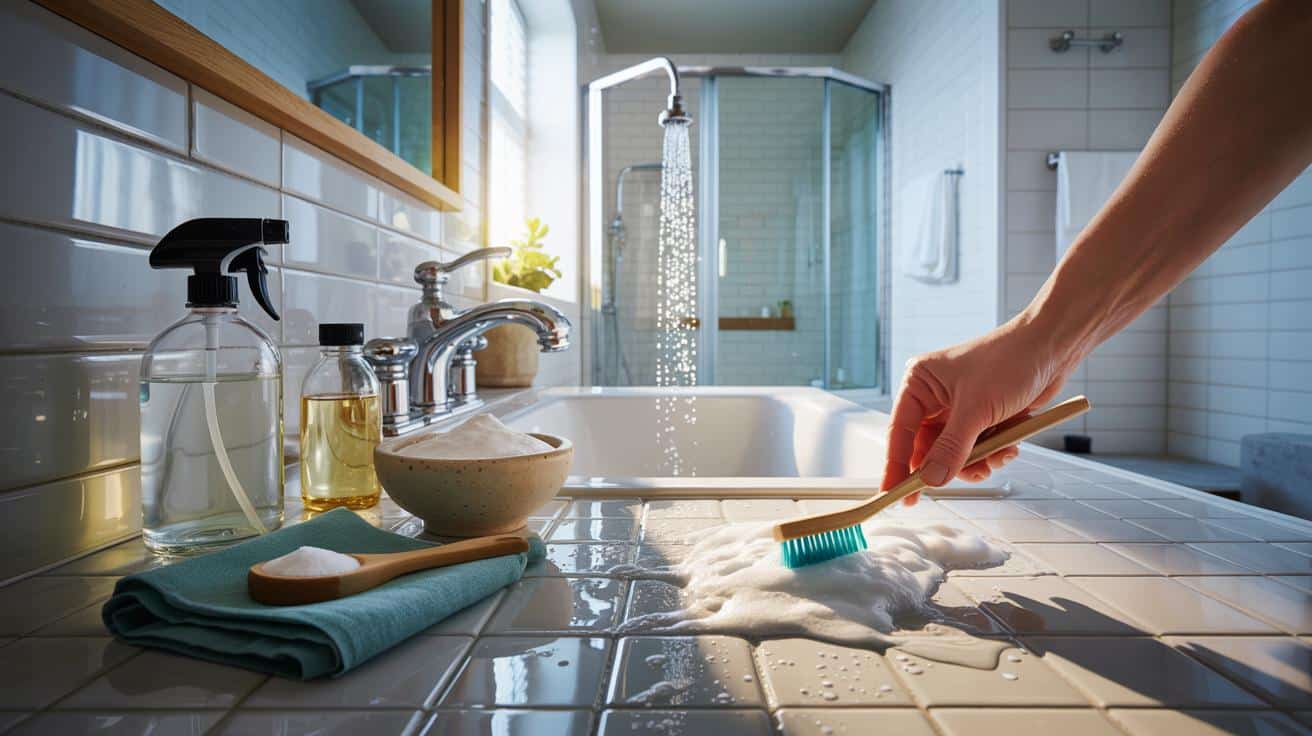Your bathroom knows the truth about your week. Steam hangs in the air, limescale blooms on the taps, and the mirror keeps quiet about toothpaste freckles. Eco-cleaning sounds noble when you’re scrolling at 11 p.m., but the next morning asks for something simple, real, and cheap. Vinegar and baking soda have been waiting in your cupboard all along, and they might be the gentlest way to bring back that just-cleaned sigh.
The room smelled like a pickle jar, the glass looked foggy, and I wondered if I’d lost my mind. Then the water marks on the shower door vanished, the tiles felt squeaky under my fingers, and the chrome reclaimed its quiet shine. I caught my reflection and laughed because it worked. I could almost hear the bathroom exhale. There’s a small kind of joy in choosing simpler tools. And something else you don’t expect.
The humble duo that outperforms your cluttered caddy
Open a cupboard in almost any home and you’ll find a half-used bottle of something citrusy and a spray with a mountain on the label. Still, it’s the **white vinegar** and **baking soda** that quietly win the long game. Vinegar is just acetic acid, about 5%, and it eats at limescale and soap scum without drama. Baking soda lifts grime, gives you a gentle scrub, and helps neutralize those stubborn bathroom smells.
We’ve all been there: crouched by the tub, battling a chalky ring that laughs at your expensive foam. A reader told me she timed it—four minutes of rubbing with her usual spray versus ninety seconds with vinegar and a pinch of soda on a damp sponge. The ring surrendered early. She didn’t need elbow-obliterating force, just patience and a bit of fizz. The best part wasn’t the sparkle; it was tossing the “miracle gel” that never delivered.
The logic is simple. Mineral deposits (calcium, magnesium) leave hard, cloudy residue, and mild acid dissolves it. Soap scum is a sticky mix of fatty acids and minerals, so you need that acidity to break the bonds, then a fine abrasive to sweep it away. Vinegar softens, baking soda dislodges. You’re not masking the problem with artificial gloss; you’re reversing it. That’s why the shine looks honest, not slick. It’s chemistry doing what it does best in your everyday mess.
From tiles to taps: the exact moves that make it sparkle
Start with the shower glass and tiles. Warm the surfaces with the water running hot for a minute, then spray a 1:1 mix of **white vinegar** and water over glass and ceramic. Wait five to ten minutes. Wipe with a microfiber cloth in slow, vertical strokes. For stubborn spots, sprinkle baking soda on a damp sponge, tap off the excess, and massage the area. Rinse, then buff dry with a fresh cloth until you hear that little squeak. That sound is your green light.
For taps, drains, and grout lines, think small and patient. Wrap a vinegar-soaked cloth around a limescale-crusted faucet, set a timer for fifteen minutes, then lift and scrub gently with a toothbrush dusted with baking soda. For grout, make a loose paste (two parts baking soda, one part water) and spread it along the lines. Mist with vinegar, let it fizz, then wipe clean. Let’s be honest: nobody really does that every day. A focused fifteen minutes twice a week keeps the beast at bay.
People often rush the wait time or drown everything in product, which backfires. Thin layers, short rests, steady pressure—that’s the rhythm.
“Give vinegar a few minutes to soften the problem, and cleaning stops feeling like punishment,” said Mara, a professional cleaner who switched her toolkit after her child’s asthma flared.
Use small tools: a dedicated toothbrush for corners, a razor blade held almost flat for old paint flecks on glass, and two cloths—one for wet work, one for the final dry buff.
- Never mix vinegar with bleach. It releases toxic gas.
- Avoid vinegar on stone (marble, travertine). Use mild soap and water there.
- Rinse metal surfaces, then dry, so the acid doesn’t linger.
- Label your spray bottle: “Vinegar 1:1” and the date.
- Open a window or switch on the fan during the job.
The part nobody tells you about clean bathrooms
We talk about shine like it’s the prize, but what changes most is how you feel in the space. The air smells neutral, not perfumed. You stop dodging the mirror. And when guests use the bathroom, there’s no flicker of apology in your throat. This is small, home-scale dignity. The fact that it costs pennies and not a miniature paycheck just makes it easier to repeat.
Switching to vinegar and baking soda isn’t about going retro. It’s about stripping away the noise of ten different formulas and trusting a simple loop: soften, lift, rinse, dry. When grime returns, you don’t panic. You know what to do, and it doesn’t require gloves that go past your elbows or a secret Sunday detox session. It’s lighter on your head and kinder to your surfaces. And it lets your bathroom be a bathroom again, not a chemistry lab.
| Point clé | Détail | Intérêt pour le lecteur |
|---|---|---|
| Vinegar dissolves minerals | 5% acetic acid breaks limescale and soap scum | Faster shine on glass, tiles, and chrome |
| Baking soda lifts grime | Fine abrasive, deodorizes without scratching | Safer scrub on tubs, grout, and sinks |
| Process beats products | Soften, lift, rinse, dry—repeatable routine | Lower cost, less stress, consistent results |
FAQ :
- Can I mix vinegar and baking soda in the same bottle?No. They neutralize each other and turn into saltwater with bubbles. Use them one after the other: vinegar to soften, baking soda to scrub.
- Will vinegar damage my bathroom surfaces?It’s safe on ceramic, glass, and most plastics. Avoid natural stone like marble or travertine, and always rinse and dry metal fixtures after contact.
- Does it really disinfect?Vinegar reduces some microbes, but it’s not a hospital-grade disinfectant. For routine bathroom cleaning, it’s fine. For illness or raw messes, follow local hygiene guidance.
- How do I deal with strong vinegar smell?Open a window, use the fan, and add a few drops of essential oil to your spray if you like. The scent fades quickly once it dries.
- What about stubborn mold in grout?Vinegar helps with soap scum and light mildew. For entrenched mold, scrub with baking soda paste, rinse, then dry thoroughly and improve ventilation to prevent return.








